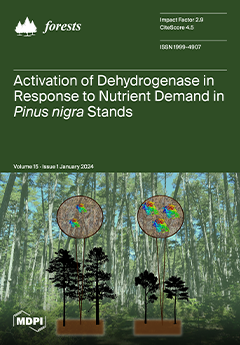Atmospheric CO
2 levels have been increasing, and these changes may result in differential adaptive responses in both genera and species and highlight the need to increase carbon sequestration. Ecophysiological and morphological responses of four early-successional deciduous species were examined under ambient CO
2 (aCO
2, 400 ppm) and elevated CO
2 (eCO
2, 800 ppm) treatments. The four species, all of which are used in restoration, were
Alnus viridis subsp.
crispa (Ait.) Turrill (green alder),
A. incana subsp.
rugosa (Du Roi) R.T. Clausen (speckled alder),
Betula populifolia (Marshall) (gray birch), and
B. papyrifera (Marshall) (white birch); all are from the same phylogenetic family, Betulaceae. We examined biochemical efficiencies, gas exchange, chlorophyll fluorescence, chlorophyll concentrations, foliar nitrogen (N), and growth traits. A general linear model, analysis of variance, was used to analyze the functional carbon efficiency and growth differences, if any, among genera, species, and provenances (only for growth traits). The alders had greater biochemical efficiency traits than birches, and alders upregulated these traits, whereas birches mostly downregulated these traits in response to eCO
2. In response to eCO
2, assimilation either remained the same or was upregulated for alders but downregulated for birches. Stomatal conductance was downregulated for all four species in response to eCO
2. Intrinsic water use efficiency was greater for alders than for birches. Alders exhibited a consistent upregulation of stem dry mass and height growth, whereas birches were somewhat lower in height and stem dry mass in response to eCO
2. Foliar N played an important role in relation to ecophysiological traits and had significant effects relative to genus (alders > birches) and CO
2 (aCO
2 > eCO
2), and a significant genus × CO
2 interaction, with alders downregulating foliar N less than did birches. Covariate analysis examining carbon efficiency traits in relation to foliar N showed clear functional responses. Both species in both genera were consistent in their ecophysiological and morphological responses to CO
2 treatments. There was supporting evidence that assimilation was sink-driven, which is related to a plant organ’s ability to continue to grow and incorporate assimilates. The alders used in this study are actinorhizal, and the additional available foliar N, paired with increased stem dry mass sink activity, appeared to be driving upregulation of the carbon efficiencies and growth in response to eCO
2. Alders’ greater carbon efficiencies and carbon sequestration in impoverished soils demonstrate that alders, as opposed to birches, should be used to accelerate ecological restoration in a world of increasing atmospheric CO
2.
Full article





